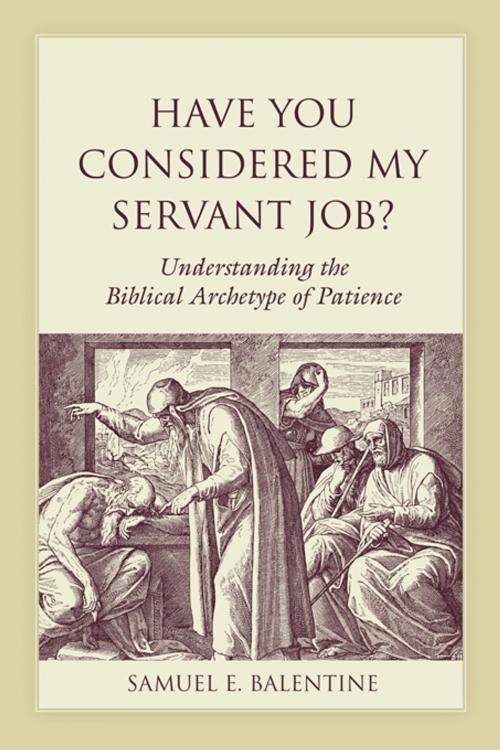Have You Considered My Servant Job?
Understanding the Biblical Archetype of Patience
Nonfiction, Religion & Spirituality, Bible & Bible Studies, Old Testament, Criticism & Interpretation, Study| Author: | Samuel E. Balentine, James L. Crenshaw | ISBN: | 9781611174526 |
| Publisher: | University of South Carolina Press | Publication: | January 9, 2015 |
| Imprint: | University of South Carolina Press | Language: | English |
| Author: | Samuel E. Balentine, James L. Crenshaw |
| ISBN: | 9781611174526 |
| Publisher: | University of South Carolina Press |
| Publication: | January 9, 2015 |
| Imprint: | University of South Carolina Press |
| Language: | English |
The question that launches Job’s story is posed by God at the outset of the story: “Have you considered my servant Job?” (1:8; 2:3). By any estimation the answer to this question must be yes. The forty-two chapters that form the biblical story have in fact opened the story to an ongoing practice of reading and rereading, evaluating and reevaluating. Early Greek and Jewish translators emphasized some aspects of the story and omitted others; the Church Fathers interpreted Job as a forerunner of Christ, while medieval Jewish commentators debated conservative and liberal interpretations of God’s providential love. Artists, beginning at least in the Greco-Roman period, painted and sculpted their own interpretations of Job. Novelists, playwrights, poets, and musicians—religious and irreligious, from virtually all points of the globe—have added their own distinctive readings. In Have You Considered My Servant Job?, Samuel E. Balentine examines this rich and varied history of interpretation by focusing on the principal characters in the story—Job, God, the satan figure, Job’s wife, and Job’s friends. Each chapter begins with a concise analysis of the biblical description of these characters, then explores how subsequent readers have expanded or reduced the story, shifted its major emphases or retained them, read the story as history or as fiction, and applied the morals of the story to the present or dismissed them as irrelevant. Each new generation of readers is shaped by different historical, cultural, and political contexts, which in turn require new interpretations of an old yet continually mesmerizing story. Voltaire read Job one way in the eighteenth century, Herman Melville a different way in the nineteenth century. Goethe’s reading of the satan figure in Faust is not the same as Chaucer’s in The Canterbury Tales, and neither is fully consonant with the Testament of Job or the Qur’an. One need only compare the descriptions of God in the biblical account with the imaginative renderings by Herman Melville, Walt Whitman, and Franz Kafka to see that the effort to understand why God afflicts Job “for no reason” (2:3) continues to be both compelling and endlessly complicated.
The question that launches Job’s story is posed by God at the outset of the story: “Have you considered my servant Job?” (1:8; 2:3). By any estimation the answer to this question must be yes. The forty-two chapters that form the biblical story have in fact opened the story to an ongoing practice of reading and rereading, evaluating and reevaluating. Early Greek and Jewish translators emphasized some aspects of the story and omitted others; the Church Fathers interpreted Job as a forerunner of Christ, while medieval Jewish commentators debated conservative and liberal interpretations of God’s providential love. Artists, beginning at least in the Greco-Roman period, painted and sculpted their own interpretations of Job. Novelists, playwrights, poets, and musicians—religious and irreligious, from virtually all points of the globe—have added their own distinctive readings. In Have You Considered My Servant Job?, Samuel E. Balentine examines this rich and varied history of interpretation by focusing on the principal characters in the story—Job, God, the satan figure, Job’s wife, and Job’s friends. Each chapter begins with a concise analysis of the biblical description of these characters, then explores how subsequent readers have expanded or reduced the story, shifted its major emphases or retained them, read the story as history or as fiction, and applied the morals of the story to the present or dismissed them as irrelevant. Each new generation of readers is shaped by different historical, cultural, and political contexts, which in turn require new interpretations of an old yet continually mesmerizing story. Voltaire read Job one way in the eighteenth century, Herman Melville a different way in the nineteenth century. Goethe’s reading of the satan figure in Faust is not the same as Chaucer’s in The Canterbury Tales, and neither is fully consonant with the Testament of Job or the Qur’an. One need only compare the descriptions of God in the biblical account with the imaginative renderings by Herman Melville, Walt Whitman, and Franz Kafka to see that the effort to understand why God afflicts Job “for no reason” (2:3) continues to be both compelling and endlessly complicated.















